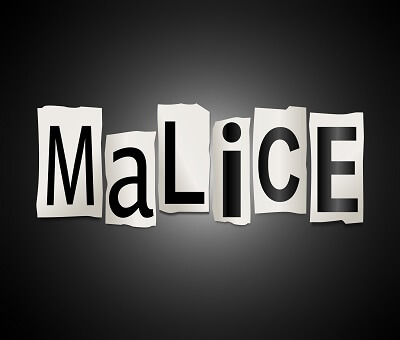
Malice refers to a “wrongful intention” or the “desire to harm someone” in carrying out an action. While it is relatively difficult to establish malice in defamation matters, once proven, the presence of malice will defeat most defences. The majority of the literature on malice in defamation law in Australia suggest that malice, whilst applicable in theory in relation to most defences, will more commonly defeat the defences of Qualified Privilege1, Fair and Accurate Reports, and Fair Comment2.
This article outlines the different types of malice recognised in common law and the respective elements required to establish different forms of malice in order to defeat a defence to a claim for defamation.
Express Malice
Express malice applies in situations where there is an improper or foreign purpose behind the publication of defamatory material that is not protected by an occasion of privilege or expression of opinion3. For example, a defamatory statement that has been published with the primary purpose of injuring the person about which the statement was made would be considered a publication made with an improper or foreign purpose and would accordingly be considered to have been published with express malice4. The improper or foreign purpose of the publication must be the central purpose of the publication for express malice to be established5.
Even where it can be shown that the defendant was aware that the publication made was likely to damage or otherwise injure the defendant’s reputation, this is not in itself sufficient to establish that the publication was published for an improper purpose in circumstances where the defendant was acting within their duty or with a sense of duty6.
In the case of Roberts v Bass7, the plaintiff was a member of State seat in South Australia and claimed that the defendant intended to injure the plaintiff’s reputation during an election by making defamatory publications about him. At trial, the court held that whilst the publications may have a basis in truth, the defendant had acted out of malice towards the plaintiff in making the defamatory publications.
Honest Belief of Truth of Publication
While many cases suggest that the concepts of express malice and lack of an honest belief in the truth of a publication are one and the same, Justice Hunt in Barbaro v Amalgamated Television Services Pty Ltd8 differentiated between the two:
‘[i]n some of the older authorities, an absence of honest belief on the part of the defendant is treated merely as some evidence of an indirect motive which alone is said to constitute express malice, but the better view, in my opinion is to treat the two as different kinds of malice’.
When a defendant publishes a defamatory publication, they may have a genuine belief in the truthfulness of that publication; however, that does not mean that the belief is reasonable9. The way to establish reasonableness is by demonstrating the defendant’s state of mind at the time of making the publication and the factors that led the defendant to believe that the publications were true10.
That a defendant had an honest belief in the truthfulness of a publication will not necessarily mean that a publication was not published with malice simply because the plaintiff fails to prove an absence of honest belief. Rather, if it can be identified that a defendant was deliberately ignorant as to whether or not the publication was true and accordingly developed an honest belief of the truth of the matter by reason of that ignorance, malice may still be established11.
Absence of Malice
There are some circumstances in which malice cannot be established, including12:
- where the result of the belief in the truth of the publication stems from carelessness, irrationality or prejudice;
- where the defendant draws conclusions from insufficient evidence; or
- where the failure to recognise the importance of material that may cast doubts on the defendant’s conclusions.
Some examples of situations where malice cannot be established include:
- where a publication is objectively false, but the defendant genuinely believes the publication to be true due to obstinacy or prejudice13; and
- where the defendant genuinely believes in the truth of a publication because the belief stems from records of events, including broadcasts of video or film14.
Proving Malice
Proving that malice is present in actuating a publication is established by the presentation of “credible, substantial evidence and not a surmise or a minimal amount of evidence” 15. Whether or not malice is present generally ought to be determined at trial rather than in interlocutory proceedings16 as the plaintiff will be required to provide supporting evidence and particulars to establish malice as a response to the defendant’s pleaded defences17.
In circumstances where malice is inferred, evidence must be provided to produce a reasonable and definite inference of malice; the same evidence may also be used to illustrate an improper purpose or lack of honest belief in the truth of the publication. 18
Intrinsic and Extrinsic Evidence
In detecting the existence of malice in actuating a publication, the courts will consider both intrinsic and extrinsic evidence. Intrinsic evidence refers to evidence inferred from the publication itself. Extrinsic evidence refers to evidence outside of the publication and may include factors such as the defendant’s conduct and evidence of spite or ill-will towards the plaintiff.
Below are non-exhaustive lists of what the Courts consider to be intrinsic evidence and extrinsic evidence in determining the presence of malice in a publication:
Intrinsic Evidence:
- Manner and extent of publication;
- Disproportion between the language and facts;
- Facts or circumstances surrounding the publication;
- Publisher was aware that publication was false;
- Satisfaction that publisher did not have honest belief in truth of publication; and
- Imputations arising from publication must have been intended.19
Extrinsic Evidence:
- Acts of spite or ill will relevant to the publisher’s state of mind, around the time of publication;
- Publisher purposely avoided further inquiries into truth of publication;
- Publisher may have published other material, around the same time as publication in question;
- Failing to apologise is unreasonable in the circumstances; and
- Publisher’s conduct of litigation.20
Corporations Acting With Malice
In order to prove that a corporation acted out of malice, malice must be established as having been present in the mind of the agent of the corporation responsible for the publication at the time the publication was made21.
Contact Harris Defamation Lawyers
Malice in defamation matters can be difficult and complex to establish, and it is often difficult to even know whether malice comes into play when a claim for defamation is brought.
Whether you are a plaintiff who is seeking to defeat a defence to a defamation claim brought against another person because you believe the defendant published with malicious intent, or you are a defendant who is concerned that a potential claim of malice may defeat an otherwise solid defence to a defamation claim brought against you, our defamation team can help you navigate your case and explore your legal rights and options. Contact Harris Defamation Lawyers today for a fixed-fee consultation about your defamation matter.



